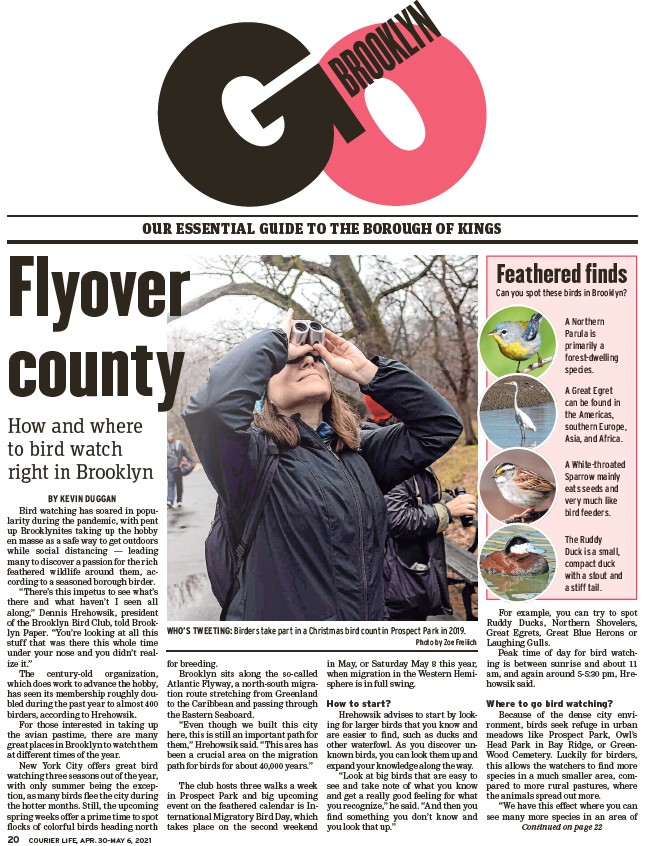
OUR ESSENTIAL GUIDE TO THE BOROUGH OF KINGS
BY KEVIN DUGGAN
Bird watching has soared in popularity
during the pandemic, with pent
up Brooklynites taking up the hobby
en masse as a safe way to get outdoors
while social distancing — leading
many to discover a passion for the rich
feathered wildlife around them, according
to a seasoned borough birder.
“There’s this impetus to see what’s
there and what haven’t I seen all
along,” Dennis Hrehowsik, president
of the Brooklyn Bird Club, told Brooklyn
Paper. “You’re looking at all this
stuff that was there this whole time
under your nose and you didn’t realize
it.”
The century-old organization,
which does work to advance the hobby,
has seen its membership roughly doubled
during the past year to almost 400
birders, according to Hrehowsik.
For those interested in taking up
the avian pastime, there are many
great places in Brooklyn to watch them
at different times of the year.
New York City offers great bird
watching three seasons out of the year,
with only summer being the exception,
as many birds fl ee the city during
the hotter months. Still, the upcoming
spring weeks offer a prime time to spot
fl ocks of colorful birds heading north
COURIER L 20 IFE, APR. 30-MAY 6, 2021
for breeding.
Brooklyn sits along the so-called
Atlantic Flyway, a north-south migration
route stretching from Greenland
to the Caribbean and passing through
the Eastern Seaboard.
“Even though we built this city
here, this is still an important path for
them,” Hrehowsik said. “This area has
been a crucial area on the migration
path for birds for about 40,000 years.”
The club hosts three walks a week
in Prospect Park and big upcoming
event on the feathered calendar is International
Migratory Bird Day, which
takes place on the second weekend
in May, or Saturday May 8 this year,
when migration in the Western Hemisphere
is in full swing.
How to start?
Hrehowsik advises to start by looking
for larger birds that you know and
are easier to fi nd, such as ducks and
other waterfowl. As you discover unknown
birds, you can look them up and
expand your knowledge along the way.
“Look at big birds that are easy to
see and take note of what you know
and get a really good feeling for what
you recognize,” he said. “And then you
fi nd something you don’t know and
you look that up.”
Feathered fi nds
Can you spot these birds in Brooklyn?
For example, you can try to spot
Ruddy Ducks, Northern Shovelers,
Great Egrets, Great Blue Herons or
Laughing Gulls.
Peak time of day for bird watching
is between sunrise and about 11
am, and again around 5-5:30 pm, Hrehowsik
said.
Where to go bird watching?
Because of the dense city environment,
birds seek refuge in urban
meadows like Prospect Park, Owl’s
Head Park in Bay Ridge, or Green-
Wood Cemetery. Luckily for birders,
this allows the watchers to fi nd more
species in a much smaller area, compared
to more rural pastures, where
the animals spread out more.
“We have this effect where you can
see many more species in an area of
Flyover
county
How and where
to bird watch
right in Brooklyn
WHO’S TWEETING: Birders take part in a Christmas bird count in Prospect Park in 2019.
Photo by Zoe Freilich
A Northern
Parula is
primarily a
forest-dwelling
species.
A Great Egret
can be found in
the Americas,
southern Europe,
Asia, and Africa.
A White-throated
Sparrow mainly
eats seeds and
very much like
bird feeders.
The Ruddy
Duck is a small,
compact duck
with a stout and
a stiff tail.
Continued on page 22